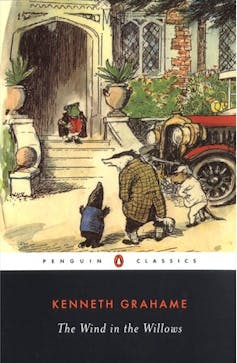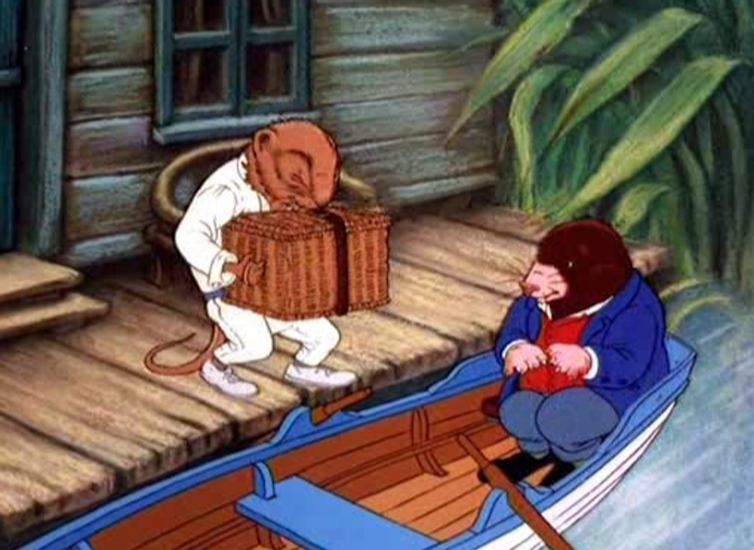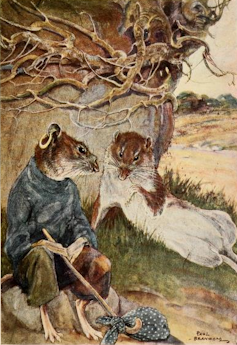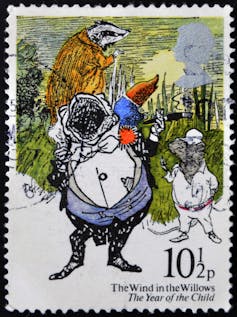The Wind in the Willows Reading Questions Chapter 4 Summary
Like several classics penned during the golden age of children's literature, The Wind in the Willows was written with a particular child in mind.
Alastair Grahame was four years old when his father Kenneth — and so a secretary at the Banking concern of England — began inventing bedtime stories near the reckless ruffian, Mr Toad, and his long-suffering friends: Badger, Rat, and Mole.
Alastair, built-in premature and partially bullheaded, was nicknamed "Mouse". Small, squinty, and beset by wellness problems, he was bullied at school. His rapture in the fantastic was afterwards confirmed by his nurse, who recalled hearing Kenneth "up in the night-plant nursery, telling Main Mouse some ditty or other well-nigh a toad".
The Wind in the Willows evolved from Alastair's bedtime tales into a series of letters Grahame after sent his son while on holiday in Littlehampton. In the story, a quartet of anthropomorphised male person animals wander freely in a pastoral land of leisure and pleasure — closely resembling the waterside haven of Cookham Dean where Grahame himself grew up.
In peaceful retreat from "The Wide World", Rat, Mole, Badger, and Toad spend their days chatting, philosophising, pottering, and ruminating on the latest fashions and fads. But when the daredevil, Toad, takes upwards motoring, he becomes entranced by wild fantasies of the road. His concerned friends must intervene to restrain his whims, education him "to be a sensible toad".

Different Toad's recuperative ending, even so, Alastair's story did not end happily. In the spring of 1920, while a student at Oxford, he downed a glass of port before taking a belatedly night stroll. The next morning, railway workers found his decapitated body on tracks near the university. An inquest determined his death a probable suicide but out of respect for his male parent, it was recorded every bit an accident.
Kenneth Grahame, past all accounts, never recovered from the loss of his only kid. He became increasingly reclusive, eventually abandoning writing altogether.
In his volition, he gifted the original manuscript of Willows to the Bodleian Library, along with the copyrights and all his royalties. Upon his expiry in 1932, he was cached in Oxford next to his beginning reader, Mouse.
Baca juga: Guide to the Classics: The Secret Garden and the healing power of nature
A 'gay manifesto'?
Biographical readings are a staple in children's literature, and the criticism surrounding The Current of air in the Willows is no exception. Commencement published in 1908 — the same yr every bit Anne of Green Gables and Dorothy and the Magician of Oz — the novel was initially titled The Mole and the H2o-Rat. After back and forth correspondence with Grahame, his publisher Sir Algernon Methuen wrote to say he had settled on The Wind in the Willows because of its "charming and moisture sound".

Today, one of the mysteries surrounding the novel is the meaning of the title. The discussion "willows" does not appear anywhere in the book; the single form "willow" appears just twice.
When Willows was get-go released in Britain information technology was marketed equally an allegory — "a fantastic and whimsical satire upon life", featuring a cast of woodland and riverside creatures who were closer to an Edwardian gentlemen'south social club than a crowd of animals. Indeed, the adventures structuring the novel are the meanderings of old English chaps nostalgic for some other time.
The four friends, though different in disposition, are spring past their "divine discontent and longing".
Restless enough to be hands bewitched, they are rich enough to fill their days with long picnics and strolls. Nearly capacity are sequenced in chronological gild, just the action revolves around different types of wandering – pottering around the garden, messing about in boats, rambling along state lanes.

With the exception of a brief encounter with a jailer'due south daughter, an overweight barge adult female, and a careless female parent hedgehog, there are no women in Willows. And excluding a pair of young hedgehogs and a grouping of field mice, all male, there are no children either.
Given the novel's potent homosocial subtext and absence of female characters, the story is oft read as an escapist fantasy from Grahame's unhappy matrimony to Elspeth Thomson. Peter Hunt, an eminent scholar of Willows, describes the couple'due south human relationship as "sexually arid" and suggests Grahame's sudden resignation from the banking company in 1908 was due to bullying on the basis of his sexuality.

Indeed, Hunt ventures to call the book "a gay manifesto", reading it as a gay allegory heavy with suppressed desire and latent homoeroticism. In ane scene, for example, Mole and Rat "shake off their garments" and "tumble in-between the sheets in swell joy and delectation".
Earlier, while sharing a bed in the open air, Mole "reaches out from nether his blanket, feels for the Rat'southward hand in the darkness, and gives it a clasp." "I'll do whatever you like, Ratty," he whispers.
For this reason, and others, some critics suggest that Willows is not a children's volume at all, but a novel for adults that tin can be enjoyed by children.
Baca juga: Guide to the classics: Petronius's Satyricon – sex, satire and naughty boys
Conservatism
Whether we read Willows as a unproblematic creature story or a social satire, the narrative reinforces the condition quo. Badger, for example, resembles a gruff headmaster whose paternal business for his friends extends to an earnest endeavour to reform the inebriate Toad.
Toad is a recognisable type of schoolboy, charming and impulsive but wildly arrogant and defective self-command. In the finish, he is punished for his foolish behaviour and forced to forgo his flamboyant egotism in apprehensive resignation at Toad Hall. Similarly, Mole and Ratty are afflicted by wanderlust, but inevitably retreat to their cosy, subterranean homes. All of Grahame'southward animals render to their "proper" place.

This render to civility and quiet domesticity exemplifies a criticism often levelled at children's literature: that such stories are more than about the fears and desires of adults than those of children. (Alice in Wonderland, for example, emphasises the importance of curiosity and imagination, but is besides an effort to socialise children into responsible citizenship.)
Willows is a story about homecoming and friendship, but also a psychodrama about uncontrolled behaviour and addiction in Edwardian England.
Creatures of habit
Perhaps the nigh famous scene in Willows — at present also a pop ride at Disneyland — is Mr Toad'southward Wild Ride. In the novel, the incautious Toad, who is oddly large enough to drive a human-sized auto, is oft in problem with the law and fifty-fifty imprisoned due to his habit to joyriding.
At times delusional, the self-proclaimed "terror of the highway" writes off several vehicles before spiralling into a cycle of machine theft, unsafe driving, and hell-raising behaviour.
Eventually, Toad'due south automobile mania becomes so unmanageable that his exasperated friends are forced to stage "a mission of mercy" – a "work of rescue" that contemporary readers might recognise every bit an intervention. This subtext of habit underpins the arc of recovery, and is crucial for understanding the novel's primal themes: the limits of friendship, the loss of pastoral security, and the temptations of city life.
Interestingly, in Annoy'due south attempt to assist Toad intermission the cycle of withdrawal and recovery, and in Toad's temporary abatement and relapse, the text points to another class of addiction: to alcohol.

When Toad is banished to his country retreat — a typical "cure" for upper-grade alcoholism at the time — Badger stresses he will remain in enforced solitude "until the poison has worked itself out of his organization" and his "violent paroxysms" have passed.
Again, the biographical foundation of the work is clear. Grahame'south male parent, Cunningham, was an alcoholic whose heavy drinking resulted, like Toad's intoxication, in social exile, financial strain, and the loss of the family unit home.
In The Wind in the Willows, Grahame employs animals to render all the ups and downs of human experience. In doing so, he captures the conflict and consonance between freedom and captivity, tradition and modernity.
Productions of The Air current in the Willows volition be held in Melbourne's Royal Botanic Gardens and Sydney'southward Royal Botanic Gardens until January 24.
Source: https://theconversation.com/guide-to-the-classics-the-wind-in-the-willows-a-tale-of-wanderlust-male-bonding-and-timeless-delight-151091
Post a Comment for "The Wind in the Willows Reading Questions Chapter 4 Summary"